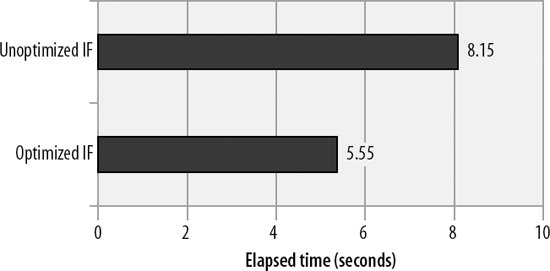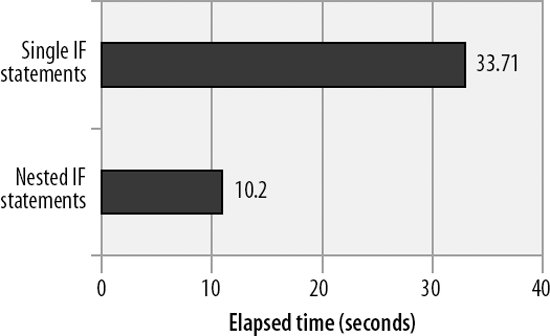IF and CASE Statements
Another category of statement that is highly amenable to code optimization is the conditional statement categoryIF and CASE statements. This is especially true if these statements are called repetitively within a loop. The essence of optimizing conditional statements like IF and CASE is to reduce the number of comparisons that are performed. You can do this by:
- Testing for the more likely matches earlier in the IF or CASE statement
- Stopping the comparison process as early as possible
22.6.1. Test for the Most Likely Conditions First
When constructing IF and CASE statements, try to minimize the number of comparisons that these statements are likely to make by testing for the most likely scenarios first. For instance, consider the IF statement shown in Example 22-14. This statement maintains counts of various percentages. Assuming that the input data is evenly distributed, the first IF condition (percentage>95) will match about once in every 20 executions. On the other hand, the final condition will match in three out of four executions. So this means that for 75% of the cases, all four comparisons will need to be evaluated.
Example 22-14. Poorly constructed IF statement
IF (percentage>95) THEN SET Above95=Above95+1; ELSEIF (percentage >=90) THEN SET Range90to95=Range90to95+1; ELSEIF (percentage >=75) THEN SET Range75to89=Range75to89+1; ELSE SET LessThan75=LessThan75+1; END IF; |
Example 22-15 shows a more efficiently formed IF statement. In this variation, the first condition will evaluate as true in the majority of executions and no further comparisons will be necessary.
Example 22-15. Optimized IF statement
IF (percentage<75) THEN SET LessThan75=LessThan75+1; ELSEIF (percentage >=75 AND percentage<90) THEN SET Range75to89=Range75to89+1; ELSEIF (percentage >=90 and percentage <=95) THEN SET Range90to95=Range90to95+1; ELSE SET Above95=Above95+1; END IF; |
Figure 22-7 shows the performance improvement gained by reordering the IF statement so that the most commonly satisfied condition is evaluated first.
Figure 22-7. Effect of optimizing an IF statement by reordering comparisons

|
22.6.2. Avoid Unnecessary Comparisons
Sometimes an IF or CASE statement will be constructed that has some kind of common condition in each comparison clause. For instance, in Example 22-16, each of the expressions in the IF statement includes an employee_status='U' condition. Even if the employee_status is not equal to "U", each of these comparisons will need to be evaluatedadding some processing overhead.
Example 22-16. IF statement with common condition in each expression
IF (employee_status='U' AND employee_salary>150000) THEN SET categoryA=categoryA+1; ELSEIF (employee_status='U' AND employee_salary>100000) THEN SET categoryB=categoryB+1; ELSEIF (employee_status='U' AND employee_salary<50000) THEN SET categoryC=categoryC+1; ELSEIF (employee_status='U') THEN SET categoryD=categoryD+1; END IF; |
Example 22-17 shows a more optimized IF structure. In this example, the employee_status is checked first and thenonly if employee_status='U'are the additional comparisons are evaluated. Figure 22-8 demonstrates the optimization.
Example 22-17. Nested IF statement to avoid redundant comparisons
IF (employee_status='U') THEN IF (employee_salary>150000) THEN SET categoryA=categoryA+1; ELSEIF (employee_salary>100000) THEN SET categoryB=categoryB+1; ELSEIF (employee_salary<50000) THEN SET categoryC=categoryC+1; ELSE SET categoryD=categoryD+1; END IF; END IF; |
To be honest, under most circumstances, tuning IF statements will not greatly improve the performance of your code. The overhead of SQL processing will usually dominate overall execution time. Consequently, we suggest that when it comes to conditional statements, you should prioritize writing readable and maintainable code. If a particular IF statement becomes a bottleneck, then you should consider a rewrite that will improve performance even at the expense of maintainability.
Figure 22-8. Effect of nesting an IF statement to eliminate redundant comparisons

|
22.6.3. CASE Versus IF
We wondered if there was any performance difference between a CASE statement and an equivalent IF statement. We thought that CASE might be more optimal for comparing a variable against a range of set values, so we speculated that this statement:
CASE customer_code WHEN 1 THEN SET process_flag=7; WHEN 2 THEN SET process_flag=9; WHEN 3 THEN SET process_flag=2; ELSE SET process_flag=0; END CASE;
might be more efficient than the equivalent IF statement:
IF customer_code= 1 THEN SET process_flag=7; ELSEIF customer_code= 2 THEN SET process_flag=9; ELSEIF customer_code=3 THEN SET process_flag=2; ELSE SET process_flag=0; END IF;
In fact, the opposite turned out to be true. The IF statement is roughly 15% faster than the equivalent CASE statementpresumably this is the result of a more efficient internal algorithm for IF in the MySQL code.
As noted earlier, we advise you to structure your stored program's statements primarily for readability and maintainability, since it is almost always the elapsed time of SQL statements that dominates performance. However, if performance is critical, you may want to make a habit of using IF statements rather than CASE statements in your code.
Part I: Stored Programming Fundamentals
Introduction to MySQL Stored Programs
- Introduction to MySQL Stored Programs
- What Is a Stored Program?
- A Quick Tour
- Resources for Developers Using Stored Programs
- Some Words of Advice for Developers
- Conclusion
MySQL Stored Programming Tutorial
- MySQL Stored Programming Tutorial
- What You Will Need
- Our First Stored Procedure
- Variables
- Parameters
- Conditional Execution
- Loops
- Dealing with Errors
- Interacting with the Database
- Calling Stored Programs from Stored Programs
- Putting It All Together
- Stored Functions
- Triggers
- Calling a Stored Procedure from PHP
- Conclusion
Language Fundamentals
- Language Fundamentals
- Variables, Literals, Parameters, and Comments
- Operators
- Expressions
- Built-in Functions
- Data Types
- MySQL 5 Strict Mode
- Conclusion
Blocks, Conditional Statements, and Iterative Programming
- Blocks, Conditional Statements, and Iterative Programming
- Block Structure of Stored Programs
- Conditional Control
- Iterative Processing with Loops
- Conclusion
Using SQL in Stored Programming
- Using SQL in Stored Programming
- Using Non-SELECT SQL in Stored Programs
- Using SELECT Statements with an INTO Clause
- Creating and Using Cursors
- Using Unbounded SELECT Statements
- Performing Dynamic SQL with Prepared Statements
- Handling SQL Errors: A Preview
- Conclusion
Error Handling
- Error Handling
- Introduction to Error Handling
- Condition Handlers
- Named Conditions
- Missing SQL:2003 Features
- Putting It All Together
- Handling Stored Program Errors in the Calling Application
- Conclusion
Part II: Stored Program Construction
Creating and Maintaining Stored Programs
- Creating and Maintaining Stored Programs
- Creating Stored Programs
- Editing an Existing Stored Program
- SQL Statements for Managing Stored Programs
- Getting Information About Stored Programs
- Conclusion
Transaction Management
- Transaction Management
- Transactional Support in MySQL
- Defining a Transaction
- Working with Savepoints
- Transactions and Locks
- Transaction Design Guidelines
- Conclusion
MySQL Built-in Functions
- MySQL Built-in Functions
- String Functions
- Numeric Functions
- Date and Time Functions
- Other Functions
- Conclusion
Stored Functions
- Stored Functions
- Creating Stored Functions
- SQL Statements in Stored Functions
- Calling Stored Functions
- Using Stored Functions in SQL
- Conclusion
Triggers
Part III: Using MySQL Stored Programs in Applications
Using MySQL Stored Programs in Applications
- Using MySQL Stored Programs in Applications
- The Pros and Cons of Stored Programs in Modern Applications
- Advantages of Stored Programs
- Disadvantages of Stored Programs
- Calling Stored Programs from Application Code
- Conclusion
Using MySQL Stored Programs with PHP
- Using MySQL Stored Programs with PHP
- Options for Using MySQL with PHP
- Using PHP with the mysqli Extension
- Using MySQL with PHP Data Objects
- Conclusion
Using MySQL Stored Programs with Java
- Using MySQL Stored Programs with Java
- Review of JDBC Basics
- Using Stored Programs in JDBC
- Stored Programs and J2EE Applications
- Using Stored Procedures with Hibernate
- Using Stored Procedures with Spring
- Conclusion
Using MySQL Stored Programs with Perl
- Using MySQL Stored Programs with Perl
- Review of Perl DBD::mysql Basics
- Executing Stored Programs with DBD::mysql
- Conclusion
Using MySQL Stored Programs with Python
- Using MySQL Stored Programs with Python
- Installing the MySQLdb Extension
- MySQLdb Basics
- Using Stored Programs with MySQLdb
- A Complete Example
- Conclusion
Using MySQL Stored Programs with .NET
- Using MySQL Stored Programs with .NET
- Review of ADO.NET Basics
- Using Stored Programs in ADO.NET
- Using Stored Programs in ASP.NET
- Conclusion
Part IV: Optimizing Stored Programs
Stored Program Security
- Stored Program Security
- Permissions Required for Stored Programs
- Execution Mode Options for Stored Programs
- Stored Programs and Code Injection
- Conclusion
Tuning Stored Programs and Their SQL
- Tuning Stored Programs and Their SQL
- Why SQL Tuning Is So Important
- How MySQL Processes SQL
- SQL Tuning Statements and Practices
- About the Upcoming Examples
- Conclusion
Basic SQL Tuning
Advanced SQL Tuning
- Advanced SQL Tuning
- Tuning Subqueries
- Tuning Anti-Joins Using Subqueries
- Tuning Subqueries in the FROM Clause
- Tuning ORDER and GROUP BY
- Tuning DML (INSERT, UPDATE, DELETE)
- Conclusion
Optimizing Stored Program Code
- Optimizing Stored Program Code
- Performance Characteristics of Stored Programs
- How Fast Is the Stored Program Language?
- Reducing Network Traffic with Stored Programs
- Stored Programs as an Alternative to Expensive SQL
- Optimizing Loops
- IF and CASE Statements
- Recursion
- Cursors
- Trigger Overhead
- Conclusion
Best Practices in MySQL Stored Program Development
EAN: 2147483647
Pages: 208

